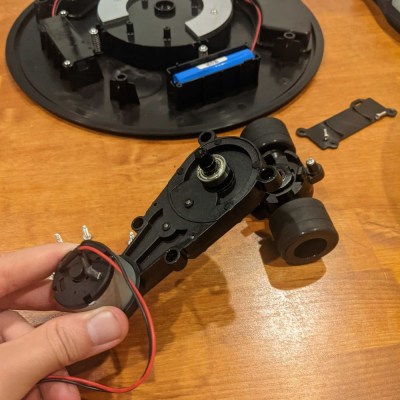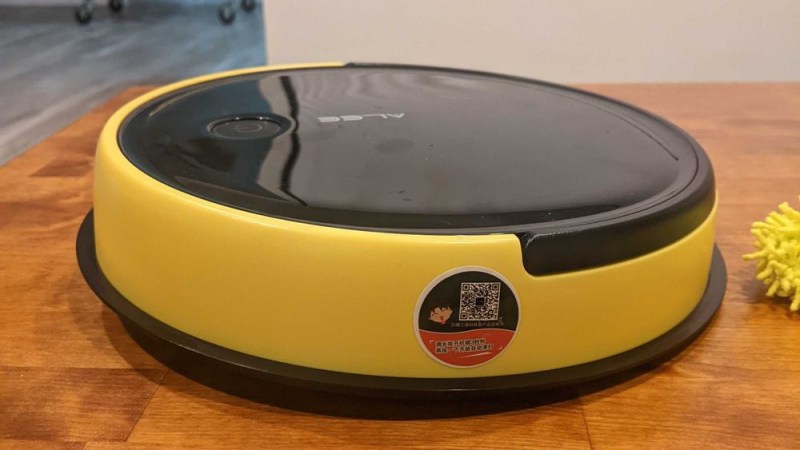The original Roomba robotic vacuum cleaner led to loads of clones and lookalikes over the years, and one of them is the ALEE mopping “robot”. [Raymond] tears it down and reveals what’s inside. Turns out it contains mostly regret! Although it does host some design cleverness in its own way.
Technically the ALEE, which cost [Raymond] a cool $85 USD, is not a robot since it has no sensors. And unless a dragging a wet cloth pad kept moist by a crude drip reservoir counts as “mopping”, it’s not much of a mop, either.

There is one interesting aspect to this thing, and it’s to do with the drive system and direction control. The whole thing is driven by a single motor, and not a very powerful one. The center of the robot has a pair of wheels that are both driven at the same rate and speed, and the wheel assembly can pivot around its axis. That’s about it. There are not even any bump sensors of any kind.
So how does this thing move, let alone change direction to (poorly) emulate an original Roomba-like crisscross pattern? The control board appears to have one job: if the motor stalls, reverse direction. That, combined with the fact that the drive unit can pivot and the enclosure is dragging a wet rag, appears to be all the chaos that’s needed to turn bonking into a wall into an undefined direction change.
It’s not great performance, but it sure is some impressive cost-cutting. You can see it bonk around unimpressively in a short video, embedded below the page break.
Just to be clear, [Raymond] knows perfectly well what he’s in for when he obtains cheap tech items from overseas retailers for teardowns. The ALEE does have some mildly interesting secrets to share, but overall, it really wasn’t worth it. Sometimes cheap tech has hacker potential, but there’s no such potential here. Seriously, don’t buy this thing.
















Vileda makes a similar device called the Virobi. It uses it’s mechanics for “collision detection.” From what I’ve heard it’s effectiveness is similar to the device above. Which explains why there’s always a couple clogging up the shelves at my local throaty store.
Was about to say the same. Very bottom of the bin stuff :’)
there used to be a toy called the squiggle ball. two hemispheres of plastic that screwed together with a rubber gasket between the hemispheres. inside was a motor, one side attached to the ball and the other to the battery. as the motor rotated, it would try to lift the battery, which changed the center of gravity and the thing would roll forward. mostly straight, using the traction of the gasket to move.
when it hit a wall, the thing would flop to one side or the other, which caused it to rotate until the gasket found some traction and it was off again.
put the thing down on a slick tile floor and it would eventually wind up *anywhere*. i suspect it could solve a maze, but i never tried it.
iRobot is already the king of cheap. No real distance sensors. No lidar. No camera. Just a bunch of switches and the cheapest IR sensors.
But the amazing thing is: It works!
Please explain this to my wife regarding our $150 robot vac.
She is convinced that I am ‘confusing it’ by moving it from room to room when it inevitably gets stuck in one, and that this is the reason for its poor navigation.
I’ve tried again and again to tell her that at best it would be programmed to follow walls and occasionally make random rotations, but she doesn’t believe me. She seems to think that it generates and keeps a map of the house.
Maybe the price point is the important part of your comment, but we had a Roomba and the app would show you the map of your house. It was pretty accurate. It was probably $300-ish though. It still got stuck in the house a lot and since actual suction would require a massive battery, the cleaning was pretty terrible and we didn’t keep it long.
Yeah. Early (and now, cheap) Roombas have no idea where they’re going and just bonk into stuff. The more modern ones actually do map, to the point where they’re supposed to be able to sense they’re full, turn off the vacuum, drive back to home base, empty themselves (the base has a vacuum and a bin), recharge, then go back to exactly where they were and start up again.
iRobot (Roombas) use cameras for this, there are instructions to leave enough lights on during mapping passes. They will also identify stuff like dog crap and drive around it (in theory).
iirc there are some competitors that use a variation on LIDAR to do the same thing, meaning they can operate in the dark.
You sure you’re thinking of iRobot? They do indeed have cameras in quite a few of the models now, and use VSLAM to build a (rather accurate) map. The reason they don’t have LIDAR is because Neato robotics hold the patent of it in robotic vacuums.
I have also a cheap robot vacuum, with only collision sensors. In a small flat, it’s enough for the job. In a larger residence, would not.
This reminds me a toy car I had when was a kid in the 80s. Exactly the same movements.
Fun for the cat
Looks like it’s playing 2D Pong.
>If the motor stalls,
So it technically has one sensor. Wheel resistance measured through motor current. Kind of like proprioception. Other than that, it’s Helen Keller without the intellect
That thing is positively sophisticated compared to the one I was given last weekend, 4 AA batteries, a power switch and a far less sophisticated motor assembly, it retails for under £20.
It might make a fairly OK cat toy with some lasers attached but honestly, I don’t think it’d survive a cat sat on it.
Don’t buy a Swiffer Wet-Jet either!
If the handle doesn’t break during normal use, the u-joint between the body and the mop head will!
Swiffer… The dremel brand in cleaning. Avoid at all cost!
It’s the rise of the machines!
We had toys in the 60s or 70s that used this same kind of mechanism where it just rolled around and when it encountered an obstacle, it would back up and head in another direction. It would do this ad-nauseum until the batteries died.